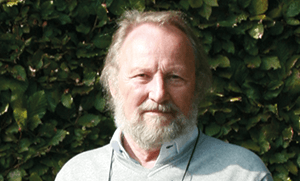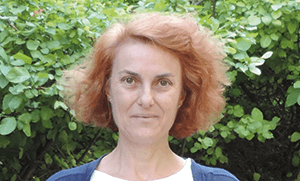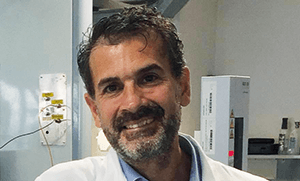What techniques fall under the umbrella of “comprehensive chromatography”?
Pat Sandra: For me (by definition) comprehensive chromatography requires two-dimensional (chromatographic!) separation with on-line, full continuous development in both dimensions. Off-line fraction collection after the first dimension and analysis on a second column is, in my definition, not comprehensive, and neither are heart-cutting (for example, GC-GC) and multiple heart-cutting (for example, mLC-LC) methods. All individual chromatographic modes combined on-line in two dimensions can be considered comprehensive. Combining phases is only possible with LC and SFC as they are both in the fluid state. Lourdes Ramos: For years, the main (and almost exclusive) comprehensive chromatography techniques (CCTs) in use by researchers have been GC×GC and LC×LC, although the latter has been slower to develop. Several research groups have now started to explore the feasibility of alternative couplings, in particular SFC×SFC and CE×CE. Investigations are at an early stage but the promising results reported to date and the potential advantages for particular application fields (for example, SFC×SFC in oil and petrochemical research) will encourage further evaluation of these new CCTs. Peter Tranchida: Good answers – I will only add that there have also been a few LC×GC experiments reported over the years. However, heart-cutting LC-GC appears to have a much more solid basis, and a wider past, present and (probably) future use. Apart from GC×GC and LC×LC, it is hard to make predictions on the future of other comprehensive 2D chromatography methodologies, as they are currently used in only a few research groups.Pat Sandra Pat Sandra is Emeritus Professor of Organic Chemistry at Ghent University, and Founder and President of the Research Institute for Chromatography (RIC), Kortrijk, Belgium. “Through the activities of RIC, I got in touch with the real analytical needs of the industry and found we could help in providing solutions that are economically relevant. Moreover, it allowed me to keep my best PhD students around me, which resulted in high scientific output in a non-academic environment,” he says.

Lourdes Ramos Lourdes Ramos is a research scientist at the Department of Instrumental Analysis and Environmental Chemistry, in the Institute of Organic Chemistry (CSIC, Madrid, Spain). Her research activities include the development of new miniaturized sample preparation methods for the fast determination of organic microcontaminants in environmental and food samples, as well as the evaluation of new chromatographic techniques – especially GC×GC-based approaches – for unraveling the composition of complex mixtures.

Peter Tranchida Peter Tranchida is an Associate Professor at the University of Messina, Italy. A food chemist, he has a great passion for separation science. Peter is a proponent and practitioner of multidimensional chromatography – and often adds a third, mass spectrometric, dimension. He believes these powerful methods can provide new insights into old samples, and help unravel the composition of complex food samples. “After each analysis,” Peter says, “I feel like a child opening up a Christmas present.”

Pat Sandra Pat Sandra is Emeritus Professor of Organic Chemistry at Ghent University, and Founder and President of the Research Institute for Chromatography (RIC), Kortrijk, Belgium. “Through the activities of RIC, I got in touch with the real analytical needs of the industry and found we could help in providing solutions that are economically relevant. Moreover, it allowed me to keep my best PhD students around me, which resulted in high scientific output in a non-academic environment,” he says. Lourdes Ramos Lourdes Ramos is a research scientist at the Department of Instrumental Analysis and Environmental Chemistry, in the Institute of Organic Chemistry (CSIC, Madrid, Spain). Her research activities include the development of new miniaturized sample preparation methods for the fast determination of organic microcontaminants in environmental and food samples, as well as the evaluation of new chromatographic techniques – especially GC×GC-based approaches – for unraveling the composition of complex mixtures. Peter Tranchida Peter Tranchida is an Associate Professor at the University of Messina, Italy. A food chemist, he has a great passion for separation science. Peter is a proponent and practitioner of multidimensional chromatography – and often adds a third, mass spectrometric, dimension. He believes these powerful methods can provide new insights into old samples, and help unravel the composition of complex food samples. “After each analysis,” Peter says, “I feel like a child opening up a Christmas present.”
How established are the two main technologies (GC×GC and LC×LC)?
LR: Today, GC×GC is a well-accepted analytical technique for the characterization of complex samples, particularly in the petrochemical, food and environmental fields. GC×GC can be considered a mature technique – that said, technological advances continue, mainly associated with the hyphenation of the technique with advanced detectors offering extra identification capabilities. By contrast, LC×LC has yet to reach maturity, despite the important progress made in recent years. Although suitable instrumentation has become commercially available, a number of technical issues limit its practical application, including problems with mobile-phase compatibility, proper focusing of the transferred fractions and detection capabilities. PS: I would argue that both GC×GC and LC×LC are mature enough to be implemented in R&D and (to a lesser extent) in QA/QC, with hardware and software commercially available and performing well. The nature of the mobile phase means that peak capacities in GC×GC are higher than in LC×LC. On the other hand, LC×LC is more powerful, as more modes can be combined (higher orthogonality) and hyphenation with high-resolution mass spectrometers is more successful (and straightforward) because of the higher peak widths in the second dimension compared to GC×GC. However, for the most part, CCTs have not yet fully moved from R&D to QA/QC labs. The exception is in the petroleum industry, where group type separations are extremely important. I have visited petrochemical sites where GC×GC is connected on-line to distillation/cracker towers. PT: If one looks into the chromatography literature, then the number of LC-MS papers is much higher compared to the number of GC-MS ones. The opposite occurs if the comprehensive 2D chromatography field is considered. It’s true that GC×GC has reached a greater degree of maturity than LC×LC; I just hope that stability does not lead to stagnation. Comprehensive 2D-LC may be less mature, but it is undergoing a lot of exciting evolution.What is the key benefit of comprehensive chromatography?
LR: Comprehensive techniques solve problems that are difficult or impossible using the corresponding monodimensional (1D) chromatographic technique. Their improved separation power has many benefits, from increased sample throughput (by simplification of the sample preparation step or simultaneous screening of several groups of compounds co-eluting in 1D techniques), to the accurate characterization of complex mixtures, or the discovery of emerging issues (such as previously unknown pollutants). PT: CCTs generate a planar separation space. Due to the use of two different selectivities, there is a higher chance of analyte separation, and the room for peak accommodation (peak capacity) is greatly increased. PS: Because of the increased peak capacity, comprehensive techniques are having an impact on (mainly untargeted) analysis of complex samples; for example, petroleum samples by GC×GC, or post-translational modifications in (bio)pharmaceuticals by LC×LC. In future, we can expect to see comprehensive separations being used to streamline workflows; for example, in QA/QC labs LC×LC-UV is simpler than LC-MS for impurity screening.What are the big milestones so far in the development of CCTs?
LR: Two key aspects contributed to acceptance of GC×GC. First, modulators allowing the quantitative and accurate transfer of the eluent from the first dimension into the second one as a narrow and focused fraction. Second, software allowing the processing and management of the large volume of data generated by the technique. Concerning LC×LC, the relatively recent commercialization of several instruments is moving this technique from highly specialized laboratories into more general use. PS: For me, the standout factors in their development have been the enthusiasm of proponents in the early years and the recent introduction of commercial systems and software. Moreover, a very important contribution in the introduction and popularization of CCTs are international symposia, such as ISCC & GC×GC (this year Riva del Garda, Italy), and HPLC (Washington DC for 2018). PT: There have been so many highlights, involving exciting applications, original column combinations, novel modulators, hyphenation with powerful MS systems (and other detectors), theoretical and optimization studies, data processing tools, and so on. If I had to choose one, it would be the concept of modulation (along with its advances), which enabled the passage from heart-cutting to comprehensive 2D chromatography – and the resulting outstanding increase in peak capacity.Where are CCTs most valuable?
PT: The greatest impact has been in untargeted applications, where CCTs have revealed hitherto unsuspected complexity. For targeted applications, on the other hand, the specificity of mass spectrometry plays a fundamental role. LR: The unique separation possibilities of GC×GC have made it particularly desirable for petrochemical, food and fragrance applications. However, GC×GC is now increasingly used for forensic, environmental and health application studies, because its enhanced resolution capability allows non-orientated (and retrospective) studies. PS: I’ll go a step further and say that CCTs are of value in all research areas where detailed profiling and fingerprinting is of utmost importance or where 1D separations do not provide sufficient resolving power – in other words, analysis of complex samples. However, they are not yet fully accepted in QA/QC labs for several reasons:- QA/QC labs (and the regulatory organizations controlling these labs) are conservative
- For many applications, it is too expensive to change standard operating procedures (SOPs)
- In many cases, no SOPs are available with these techniques
- QA/QC labs are mostly doing targeted analyses
- Quantitation is still difficult, requiring complicated software
How does the impact of LC×LC compare with GC×GC?
PS: In the long term, I believe that LC×LC will prove more impactful and widely applicable than GC×GC for three reasons. First, there are many more involatile compounds than volatiles. Second, a larger number of orthogonal modes of LC can be combined, compared with GC. Third, LC is much less efficient than GC, so the benefit of additional dimensions is greater. So why hasn’t LC×LC taken off? There are two main reasons: i) a large number of LC methods are developed under regulated conditions so are time-consuming to change, and ii) commercially available instrumentation was lacking until recently. Moreover, LC users have proven to be much more conservative than GC users. However, applications for LC×LC are emerging, including foodomics, stability studies of small-molecule pharmaceuticals, post-translational modifications in biotherapeutics, omics, and heavy petroleum products. LR: LC×LC allows the analysis of both volatile and non-volatile compounds, which in principle could mean that it has broader applications once it reaches maturity. Nevertheless, the improved resolution provided by GC×GC and the limitations of LC detectors makes me think that the two techniques will remain complementary for a long time to come. PT: LC×LC was introduced around the same time as GC×GC, over 25 years ago. However, the number of published papers in LC×LC is much lower than in GC×GC. There are certainly more variables to be optimized in LC×LC, and more difficulties in the coupling of two LC dimensions. Furthermore, the first-dimension/second-dimension flow ratio is often low, leading to problems with dilution and MS hyphenation.What have been the pitfalls in GC×GC development? Any lessons learned for LC×LC?
LR: Looking back through the literature, CCTs have been used for the resolution of an extremely limited number of analytes. And though this may be acceptable as a proof-of-concept, it is difficult to justify in subsequent application studies. Likewise, researchers must determine whether the goal of their study justifies the use of the powerful CCT configurations sometimes seen. PS: I agree with Lourdes that GC×GC is too often used in studies where fewer dimensions would have sufficed. For targeted analysis GC-MS/MS remains the standard, and even in untargeted applications GC-GC and mGC-GC may have sufficient resolving power. GC×GC has other limitations too – high-speed (low resolution) MS systems are still mandatory for optimal performance, data handling is complicated, and too few quantitative studies are published. We need to develop more validated SOPs for QA/QC, and emphasize producing quantitative data with relative standard deviations (RSDs), rather than a nice contour plot for a report/publication. PT: An important lesson is that we must give mass spectrometry its due. We are apt to focus too much on the spectacular appearance of 2D chromatograms, and sometimes forget about the great amount of information present in mass spectra – and the capability of MS to distinguish between co-eluting compounds.PS: I agree with Peter – developments in mass spectrometry in recent years have been immense. Ultimately, we must focus on what technique gives us the information we need.




